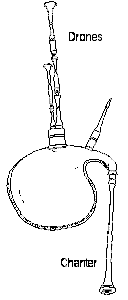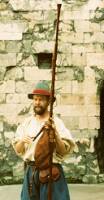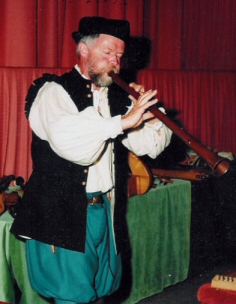
Bagpipes and ShawmsThis page refers to both medieval & Tudor instruments Zoom straight to SHAWMS Zoom straight to SHAWMS
BAGPIPESWhat did they look like? ... and what evidence is there for that?Lots of people think bagpipes are Scottish.They aren't. | |

|
Pipes in Medieval and Tudor times came in many shapes and sizes. We don't know all about them, and there aren't any left, so we have to rely on pictures and carvings from the time. To be bagpipes, they all have a bag, a chanter, where you play the tune, and usually one or more drones. Drones each play one note all the time. (Probably not much fun being a drone, then.) They also have a pipe to blow the air in, called the blowpipe. |
 See pictures of modern re-constructions of bagpipes.
See pictures of modern re-constructions of bagpipes.
|
 See images of old pictures and carvings.
See images of old pictures and carvings.IF you really want to show off, you call it ICONOGRAPHY ! P.S. Please be patient if you're not on broadband connection, these are quite big pictures and you may need to go and have a small snack while they download. But they're worth it! |

|
Click on this small picture to see a larger one. |
 I'm grateful to Julian Goodacre for allowing me to use his publications of the Durer piper print, and the Chaucer's piper print. Visit his website at:
http://www.goodbagpipes.co.uk
I'm grateful to Julian Goodacre for allowing me to use his publications of the Durer piper print, and the Chaucer's piper print. Visit his website at:
http://www.goodbagpipes.co.uk
SHAWMS |
 ... back to the top ... back to the top
|

|
S
 |
The shawm on the left is clearly a modern copy similar to the one in Michael Praetorius' book Syntagma Musicum - the one on the right Try clicking on either shawm. I hope to assemble more pictures of old instruments. They come in various sizes and shapes, but have the reed poking out at the top, usually from a bit called the pirouette, and generally have a bell shape at the bottom end. There are two holes side by side, (a bit below the hand in the picture.) One is blocked with wax. If you want to change from right to left handed playing, you just swap the wax round. Neat! |
| See pictures of shawms new and old. | ||
 Then there was the bass curtal... Then there was the bass curtal...
|

|

|
Here you see a modern reed, and a 400-or-so year-old one - two blades of cane reed fastened together so they press together at one end, and make a tube at the other. |

|
If you don't yet know how to make a noise by blowing between your two thumbs with a grass stalk pressed together between them, you could get someone to show you, or you could keep quiet... and everyone will have a quieter life round you! (It makes a good shriek!) The reed makes much the same noise. Stick it down the end of a wooden tube, and it gets a lot louder, and like a recorder, the finger holes make the right notes. That is to say, when you've practised. Shawms are a LOT harder than recorders to keep in tune. As for bass curtals, people make a lot of unkind remarks about cows while you're practising. Just about all shawms are made from a round tube of wood. Some have metal or horn bells at the bottom end, to make them even louder. |
|
Who played them?See the answer to the same question for bagpipes, further up. Shawms make your face look as if it's doing seriously hard work. It is - blowing a shawm IS hard work!. So again, the gentry would probably leave it to the professional musicians to do the work for them. ... as you can see from this picture, taken in Dover cinema of all places! (Thanks greatly for being allowed to use this pic.) |

|
 Return to top of this page.
Return to top of this page.